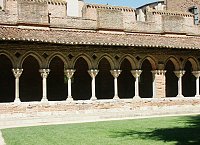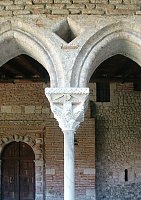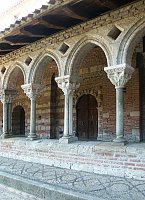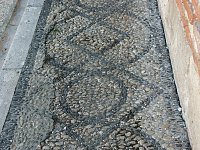
|
Looking northeastBuilt around 1100-1105, this cloister is one of the earliest with monumental sculpture. This relief sculpture is seen in panels on the two inner faces of the corner piers which reinforce the arcades. Intermediate piers also serve for support but only one of those piers has relief sculpture, while another is engraved with an inscription giving the date of the consecration of the cloister (1100). It is also one of the oldest surviving cloisters with historiated capitals. Of the 76 capitals in the four galleries, 45 are narrative while 31 are purely decorative; the themes of these capitals are taken from the Old Testament, the life of Christ, the Apocalypse and the lives of the Apostles and other saints. |
| |
|
| A gallery showing the intermediate support pier |

|

|
Piers as well as single and double columns support the arcades. The vast garth measures 101 feet by 88 feet with twenty arches on the east and west and eighteen on the north and south. Although the pointed arches were reconstructed in the 13th century, the capitals are Romanesque. Conceivably the capitals were also rearranged since the placement seems random with no discernible unity or organization. |
| |
|
 |
The capitalsAlthough the capitals at the corner piers are three-sided and supported by half-round engaged columns, the other capitals have single or paired shafts. Whether single or double, the capital is shaped like an inverted truncated pyramid and has a rectangular impost block. The capitals are circular at the base and rectangular above at the impost. The very top of the impost is less decorated, often with repeated scallops or ridges while the lower section, usually beveled, has a wide variety of decoration--animals (often fantastic), flowers, palmettes, etc. The capital itself often illustrates a remembrance of classical forms with volutes springing from the center. The capitals have four faces and on historiated ones, separate incidents of the story may continue around the capital. The shape for the carving is of course a trapezoid with the broader side at the top. A number of the capitals have inscriptions as well to identify the events. |
| |
|
A gallery showing alternating support systemPebble mosaics surround the outside edge of the arcade. |

|

|


 Go to Moissac Index.
Go to Moissac Index. Click here to return to index of art historical sites.
Click here to return to index of art historical sites.
 Click here to return to index of artists and architects.
Click here to return to index of artists and architects.
 Click here to return to chronological index.
Click here to return to chronological index.
 Click here to see the home page of Bluffton University.
Click here to see the home page of Bluffton University.

